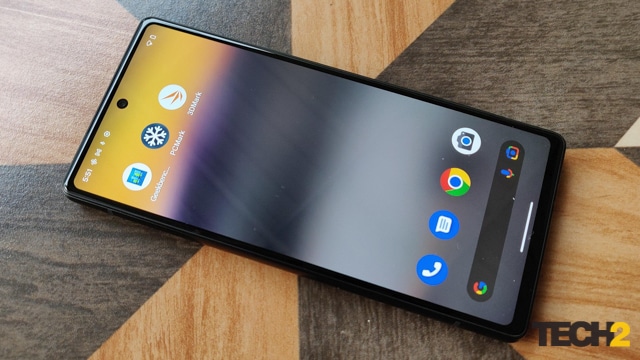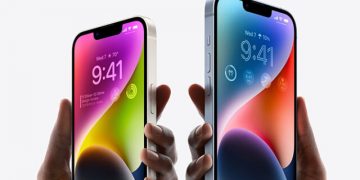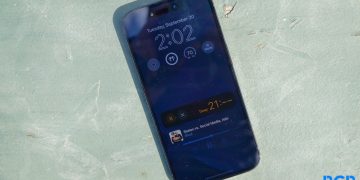Ameya DalviOct 12, 2022 20:39:23 IST
Pros:
– Unique design, feels great in the hand
– IP67 ingress protection
– Excellent camera performance, neat software tricks
– Google Tensor chip is fairly powerful
– Sharp OLED display
– Android 13
– Good battery backup
Cons:
– 60 Hz refresh rate for the display
– Plastic back is a smudge magnet and prone to scratches
– Slow charging
– No charger in the box
Rating: 3.5/5
Price: Rs 39,999
Summary: The Google Pixel 6a was not a straightforward recommendation at its launch price of 40K+, but at its current discounted price of close to 30K in the ongoing festive sales, it is hard to ignore, especially for its camera quality.
Image Credit: Tech2 | Ameya Dalvi
The Google Pixel 7 series is upon us and here we are still talking about the Pixel 6a. Why? Because when we embarked on a long-term review of the 6a, trying to assimilate the Android 13 update and combating the unusually bad September weather in Mumbai for some good light photography, we did not expect Google to launch the 7 series here so soon. Don’t think you expected it either given the company’s track record in India so far, right?
As things stand right now, and with sufficient data about the Pixel 7 phones at hand, we feel the Pixel 6a may be an important element of Google’s smartphone trinity in India. So let’s get to know this phone better so that you can decide if it’s worth your money, and more importantly, worth how much money.
Google Pixel 6a Design: Feels great in hand, but a glass back would have been nicer
The build quality of the Pixel 6a is quite solid courtesy of an aluminium frame. Adding to the sturdiness is an IP67 rating for dust and fluid resistance. However, the back of the phone is made of plastic/polycarbonate, and it’s glossy too. That makes it prone not just to fingerprints and smudge marks but also to scratches. Using a back cover would not be a bad idea here. The camera band makes the phone design distinct but a fair bit of dust accumulates below it. Despite all that, the phone feels great in hand; not very light but with perfect weight distribution.
![]()
Image Credit: Tech2 | Ameya Dalvi
The volume rockers as well as the power button are placed along the right edge. We are used to having them on opposite sides of the screen, and I often ended up altering the volume when looking to press the power button. The placement of the in-display fingerprint scanner is spot on, and one could access it without stretching the thumb much. The SIM tray is located along the left edge of the phone while a USB-C port and a speaker are present along the bottom edge. Neither a memory card slot nor a 3.5 mm headphone jack is present here.
![]()
Google Pixel 6a Display: Sharp display limited by 60 Hz refresh rate
The Google Pixel 6a has a 6.1-inch Full HD+ OLED display that is protected against scratches by a layer of Corning Gorilla Glass 3. The screen is quite sharp, is HDR compliant and the colour reproduction is impressive. But the refresh rate is limited to just 60Hz. I know this is a budget phone (for Pixel standards) but they should have opted for at least 90Hz if not more, given that phones costing half as much offer a 90Hz fresh rate these days, if not 120Hz.
![]()
Image Credit: Tech2 | Ameya Dalvi
6.1-inch is just the right screen size in my opinion, but I like compact phones. If you are habituated to larger displays, you may find this small and will need some getting used to. The bezels on all four sides of the screen are quite prominent, with the bottom bezel being the most conspicuous. At the top centre of the screen, you get a small cutout for an 8MP selfie camera.
Google Pixel 6a Performance: The Google Tensor chip has ample muscle for a midrange phone
The Pixel 6a is powered by Google’s Tensor processor, and I was quite curious to know how powerful it truly is. It certainly isn’t as powerful as Qualcomm’s Snapdragon 8 Gen 1 chips, but I don’t think there’s any phone south of 35K that boasts of that SoC. After running multiple benchmarks, I can place the performance of the Tensor close to the Qualcomm Snapdragon 870 SoC. You get just one variant of the phone with 6 GB RAM and 128 GB UFS 3.1 storage, and there is no option to expand the storage further either.
The Tensor processor doesn’t break a sweat in day-to-day tasks like accessing social media or chat apps, watching videos, browsing the internet, opening multiple tabs or switching between them. Things were smooth in photography and gaming too, though you cannot opt for the highest visual settings in games. The phone stays cool in general tasks but does get warm if you indulge in photography or videography for a few minutes, or after 30 minutes of gaming. There was no heat-related crashes though.
Moving on to synthetic benchmarks, we compared it to the OnePlus Nord 2T with a Mediatek Dimensity 1300 chip and the OnePlus 9R with a Snapdragon 870. In Geekbench 5, the Pixel 6a scored 1052 and 2872 in the single-core and multi-core tests respectively. In comparison, the Nord 2T managed 778 and 2858, while the OnePlus 9R reached 974 and 3101 respectively in the two benchmarks. PCMark Work 3.0 scores stood at 9818, 9355 and 11266 respectively for the 6a, 2T and 9R.
To test the gaming capabilities, we ran the Wild Life and Wild Life Extreme tests from the 3DMark suite, and the Pixel 6a shot past the other two comfortably in both those tests. The Pixel 6a scored 6358 (average FPS: 38.10) and 2092 (average FPS: 12.50) as compared to 4563 (average FPS: 27.30) and 1328 (average FPS: 8) for the Nord 2T and 4245 (average FPS: 25.40) and 1223 (average FPS: 7.30) for the OnePlus 9R. One can concur that the Pixel 6a is better at gaming than the other two, but not in the same league as the Snapdragon 888 or Snapdragon 8 Gen 1 chips from Qualcomm.
![]()
This phone has two speakers, one behind the earpiece and the other at the base of the phone. Collectively they produce a reasonably loud and balanced output with fair stereo separation. The phone is Bluetooth 5.2 compliant and the dual-band WiFi compliance is quite impressive with support for a/b/g/n/ac/6e standards. The call quality and reception were perfectly fine during the course of our testing. The fingerprint scanner is occasionally temperamental but generally works fine.
Google Pixel 6a Battery performance: Good battery life, slow charging
The battery backup on the Pixel 6a is pretty decent. The phone has a 4410 mAh battery that easily lasts close to a day and a half of moderate use, which is perfectly acceptable. The charging times are quite disappointing though. Like phones from most ‘premium’ brands these days, Google does not include a charger in the bundle. Also, the phone only supports 18W fast charging; not sure we can call that fast anymore. It takes close to two hours to charge the phone fully from almost zero. I tried using multiple chargers to speed up the process but in vain. Wireless charging isn’t supported either, but I can live with that.
![]()
Image Credit: Tech2 | Ameya Dalvi
Google Pixel 6a Camera performance: This is what you buy this phone for
The Pixel phones have been a classic case of quality over quantity. While rival brands opt for multiple cameras on their devices, Google has persisted with just two at the back of the Pixel 6a. And what’s more, we have two 12MP modules, and not ones that flaunt 48, 64 or 108 megapixels. The primary camera supports optical image stabilisation (OIS) and the second capture ultrawide shots with 114 degrees FOV. Despite the modest numbers, they deliver where it matters – image quality.
While the camera hardware is important, Pixel phones have proved over the years the important role the software plays in producing great looking shots. The Pixel 6a is no different, and its output can put to shame many higher megapixel cameras on several phones. The colour reproduction of the images captured with the main camera is close to natural. The contrast is excellent with equally good detail and dynamic range. This is applicable for low-light photography too, more often than not. The phone automatically switches to Night Sight mode which does a great job and keeps the noise in check.
![]()
Image Credit: Tech2 | Ameya Dalvi
The portrait shots have always been great on Pixel phones, and they are great here too with near perfect foreground and background separation. Though it doesn’t let you adjust the level of background blur manually, it generally gets it right on its own. The 12MP ultrawide camera is pretty good too and one of the better ones around. While the performance is not at the same level as the main camera, the colours and dynamic range are comparable in good light, but the details are a notch lower. Best to stick to the main camera for low light shots.
You don’t get a telephoto camera on the Pixel 6a, and the zoom available here is digital. However, using 2X zoom on the main camera produces good results. Beyond 2X there is a noticeable dip in quality. This phone can record 4K videos at 30 and 60 fps and you can go as high as 240 FPS for 1080p videos. You get OIS and EIS support to compensate for the shakes. The recorded videos are good, but not great. The 8MP selfie camera does a fair job, and the skin tones look natural. It can capture surprisingly good portrait shots too.
Click here for unedited camera samples.
OS and user interface: The cleanest Android 13 around
We received the Pixel 6a with Android 12 out of the box, and midway through the testing, it received the Android 13 update. As with all Pixel devices, you get the pure Android experience without any bloatware, and with the Material You design. The Android 13 UI looks fluid and is totally lag-free on this device. In fact, some of the quirks that were a part of Android 12 on this device were polished off with the Android 13 update.
As I mentioned earlier, the camera output on the Pixels is as much of a software play as the hardware. In addition, you get some really cool tools to edit images on the fly. The Magic Eraser and Camouflage options are more than handy. The former lets you remove objects or humans from the images within seconds by simply circling them; goodbye photo bombers. It doesn’t always work as precisely as a professional photo editing suite, but it’s certainly good to have. Camouflage helps in changing the colour of certain objects in the image to subtly blend in. There’s more for you to explore.
![]()
Final words:
The Google Pixel 6a launched at Rs 43,999 in India with a one-year warranty, with Flipkart being the official retail partner. That was way too high for what the phone offers. It then settled around Rs 39,999, which was still quite high. But thanks to the ongoing festive sales, it is down to Rs 34,199, and on a good day or with the right credit cards, you can even score it for under 30K, which is an excellent deal.
Having said that, the Google Pixel 6a is not a phone for all, but primarily for photography enthusiasts and those who like a pure Android experience. You only get the 6 GB RAM and 128 GB storage variant of this phone, and there is no expandable storage option either. The phone lacks quite a few modern features like a high refresh rate display and fast charging, but the camera output is second to none in the 30K to 35K price band. The Tensor processor coupled with some software magic handles image processing very well.
The Android 13 experience is also quite fluid, and even with modest RAM, things run smoothly. If that matters to you along with photography above all else, the Google Pixel 6a is a good choice closer to 30K (but not 40K). If gaming is a higher priority or if larger, high refresh rate displays are non-negotiable, there are plenty of options in this price bracket that can address those needs. Some options that come to mind are Realme GT 2, iQOO 9 SE 5G and the Motorola Edge 20 Pro. Choose one based on the features you desire the most.
Source by www.firstpost.com




























